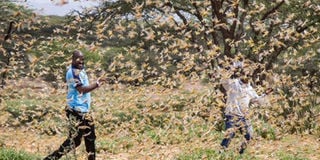Can indigenous knowledge make a difference in fighting locusts?

What you need to know:
- Whereas civilisation and advances in technology may suggest new measures, it is certainly important to optimise such practices with past efforts rich in indigenous knowledge.
I have been keenly following the progression of the desert locusts given that they pose threat to life. The government has been involved in monitoring of the movement of the swarms with strong messages to farmers to report any sighting of the insects in new districts.
The government also procured chemicals and knapsack sprayers to complement the efforts of aerial spraying using a chartered specialised plane. In my opinion, the locusts have been largely forgiving. Not so much damage has been reported albeit with fears that huge quantities of eggs have been laid, and waiting for the right conditions (rain is around the corner) to hatch and wreck havoc!
This is not the first time locusts have invaded Africa in general and Uganda in particular. This begs the question: How did the previous generations deal with locust invasion? I read a story titled, ‘To kill the locusts, but not destroy the farmers: Officials, farmers and the plagues of the pharaoh. c 1920-35’ by Liz Marie Van Der Waat; in pre-apartheid South Africa.
Just like in Uganda’s fight against locusts today, there is no simple correlation between money spent and locusts killed, and yet the environment was being degraded by these efforts!
Whereas Marie dwells on the political and social cultural dimensions of the plague of the time, she gives a good account of the efforts undertaken. Perhaps, the most important stage to destroy locusts is in the earlier stages of their life cycle (eggs and nymphs). Marie suggests that first, locusts were controlled through burning entire fields at the onset of land preparation, while others ploughed gardens to buy the eggs and nymphs.
The use of natural enemies of locusts such as the locust flies (Wohlfahrtia pachytyli), a facultative parasite that feasts on locust eggs, was used. Other known parasites include pathogenic fungi and different bird species. Additionally, methods such as use of cattle dip residue to poison locusts; a practice that would raise concern among environmentalists today were used. The swarms were so significant that a locust policy was developed that instituted “locust committees and locust officers.”
Whereas civilisation and advances in technology may suggest new measures, it is certainly important to optimise such practices with past efforts rich in indigenous knowledge.
For as long as locusts have existed, they have had an inability to heed to political borders, therefore suggesting that governments, with the advent of information technology, need to develop concerted efforts geared towards controlling the locusts.
Aine Isaiah,
[email protected]




